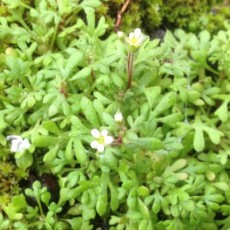Guest post by Richard Harrison
On the 23rd March 2020, in order to reduce the spread of the coronavirus SARS-CoV-2, the British Prime Minster Boris Johnson announced to the House of Commons that the UK government would be informing people that they must stay at home and that certain businesses should close.
I therefore joined 1.7 million people and started working from home, with the inability to visit friends and family, and to only leave the house for essential business and for one hour’s exercise per day.
These are selected entries from the diary I kept during this unique period in our history, recording the wildlife in our small garden in a town near Oxford.

Wednesday 1st April
Struggling to come to terms with the strange working environment, what would have been a five-minute conversation at work is now endless zoom and Microsoft Teams calls.
But our mini wildlife meadow is providing an escape from it; planted over several years, the snakes-head fritillaries are now in flower. A seemingly exotic plant, it was first recorded in 1780 and was once found in abundance in wet meadows across southern England, but like so many plants and animals it has seen a huge decline since the move to mass agriculture after the second world war.
In a pre-Covid world, we would head to Iffley Meadows or Magdalen College in Oxford where they grow in their thousand. Or to Ducklington, where the meadow – with its thousands of fritillaries and next to the River Windrush – is open to the public for one day each year.
But this is not a normal year, so the ten or so plants that inhabit are garden (purchased from local supermarkets) are providing a much-needed respite in what is a very difficult time.
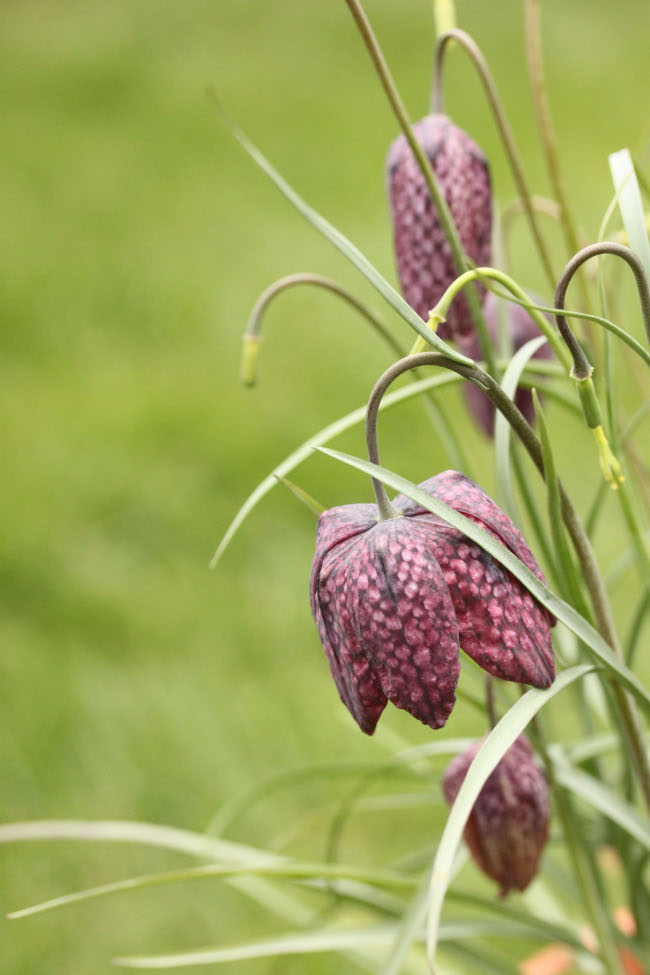
Sunday 12th April – Easter Sunday
Another increase of 5,288 infections announced today.
But there is some good news for a change (actually quite amazing): for the first time in over 10 years, the unmistakable sign that at least one hedgehog has visited the garden.
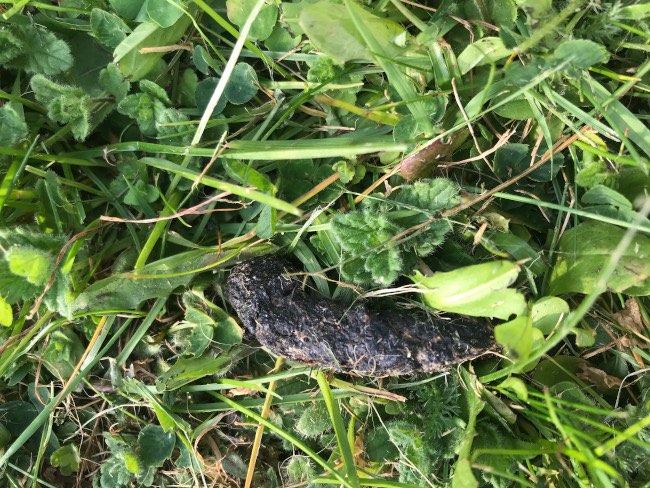
Hedgehogs have had a disastrous time recently; there has been an estimated decline in their numbers of 97% since 1950. And the trend does not seem to be reversing; if anything, it is getting worse.
There are many possible explanations why hedgehogs are not prevalent in our garden – lack of suitable habitat, local residents using slug pellets, as well as hedgehogs being killed by cars as they walk around their territory, covering over two miles in a single night.
Perhaps one of the few good things about lockdown is less traffic and therefore fewer hedgehogs being hit.
Still, a lockdown hobby will be trying to get a glimpse of our elusive garden guest.
Thursday 16th April
The infection rate is still increasing (4,617 announced today), but at least after a very few damp weeks it seems spring is finally here.The red mason bees have emerged and are seeking nesting sites. They are most frequently seen on our southern facing fence, where there is a home-made solitary bee nest box, consisting of bamboo canes and holes drilled in the wood.
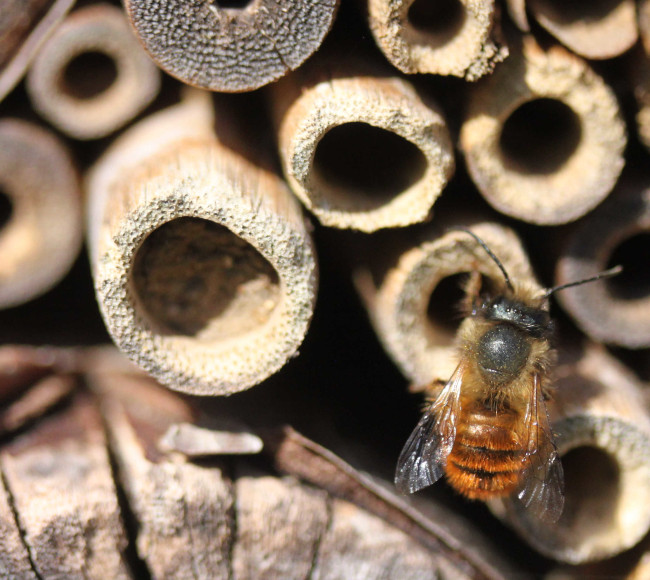
The red mason bee is one of 250 species of solitary bee found in the UK and the females use the holes to lay eggs, packing each one with pollen (sometimes gathered from the snakes-head fritillaries) before securing it with mud and laying another egg.
As for most animals, life as a mason bee is not straightforward: lurking within the holes are jumping spiders, which try (and frequently fail) to grab a bee.
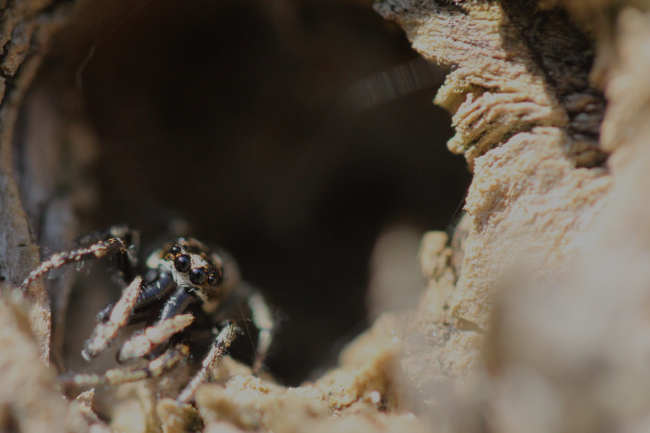
The bees’ flight season lasts to July, so hopefully they will continue to enliven our now accidentally rewilded garden.
Saturday 25th April
In our garden there is a very shabby home-made bird box. I don’t know how long it has been up – maybe 10 years, maybe more – and I don’t think it has ever been used (I was considering throwing it away) but it seems a pair of great tits have moved in. Hopefully this will provide some much-needed relief from what our world is going through.
Friday 8th May
VE Day – no bunting, no street parties, no celebrations, just an eeriness hanging over the nearby streets, as if life has somehow been paused.
But the wildlife has not stopped. The extra bank holiday has presented the ideal opportunity to get up at 5 AM to experience the dawn chorus in the nearby fields; and what a fantastic natural orchestra – great tits, wood pigeons, a yellowhammer (only the second I’ve ever seen) and skylarks (I didn’t know that they nested so close to where we live), and assorted warblers, including a whitethroat.
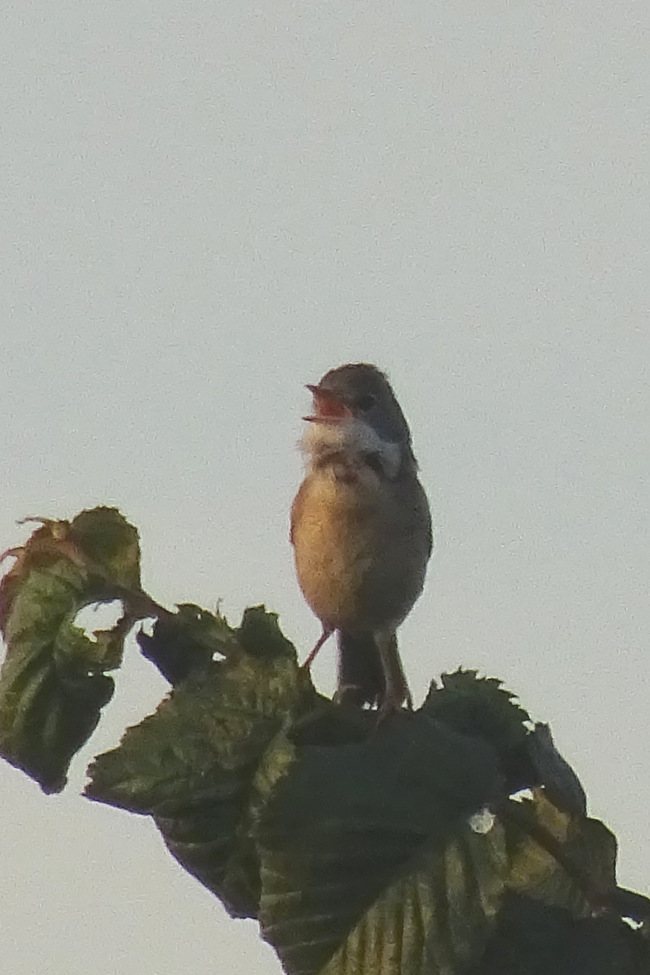
And a stunning solo performance by a song thrush.
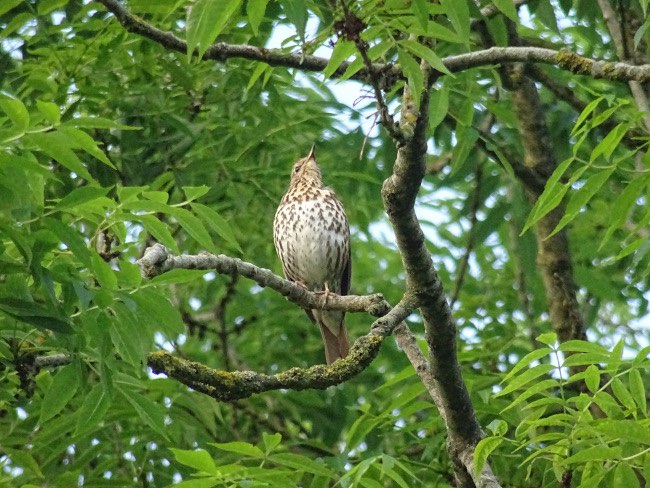
PM: Sat in the garden, the stillness is broken by the sound of a bugle playing the last post, more emotive than any planned celebration.
Trying to take photos of the great tits (and failing). There must be 20 red kites circling overhead; our next-door neighbour (who has lived here for nearly 50 years) has never seen so many. Maybe someone is feeding them? Or perhaps the lack of cars has reduced the amount of carrion they can feed on, resulting in them seeking new sources of food?
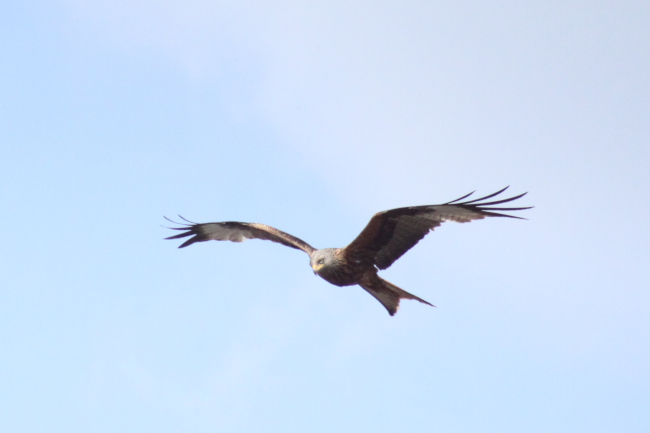
Persecuted by landowners and egg thieves, by the start of the 20th Century there were only a few breeding pairs in Wales, but a reintroduction project of birds from Europe in the nearby Chilterns in the early 1990s and recent re-introductions the east midlands and northern England has seen the UK population recover to nearly 10,000.
So more of us can now spend an afternoon watching the breathtaking sight of them soaring overhead, and knowing they were once extinct in England makes it even more of a privilege.
Saturday 9th May
23o C – ouch
The great tits are still active and I managed to get a photograph of one of the parents leaving with a faecal sac (the poo of their chicks).
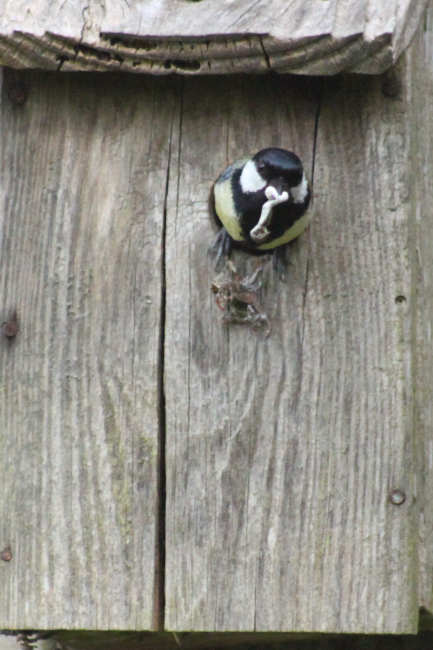
Trying to photograph these birds (even if unsuccessfully) has been a great source of distraction from the current woes of the world.
The red kites were being mobbed by the unmistakable shape of a peregrine falcon; such a privilege to see such a remarkable bird from our own garden.
Peregrines, like red kites, have returned from the brink of extinction. But this time it was not a proactive reintroduction, but a change of attitude. In the 1960’s it was discovered that the peregrine population in the UK had declined by 80%, with only a few pairs in northern Scotland still breeding. The decline was linked to pesticides such as DDT, which meant eggs were unviable. After these pesticides were banned, the peregrine population started to recover and there were over 1,400 breeding pairs in the UK in 2002. And that number has almost certainly increased in recent years as they have learnt to exploit man-made habitats for nest sites and hunt the birds that live in them.
The bird life continues, with swifts and house martins returning from their winter in southern Africa.
Sunday 10th May
Daily infections are now declining (3,923), so it seems that lockdown is working.
Another hot day, sat outside watching the great tits – what fantastic natural entertainment – and several swifts now flying overhead.
A local cat has found the great tits and is hanging around near the nest box. Shooed it off, but it will return. Great tits can fledge after 18 days, so hopefully they will leave before the cat works out how to get into the box (or scares off the adults). Tense times ahead.
Thursday 13th May
THE CAT IS SAT ON THE BIRD BOX!!!
Sunday 16th May
The cat is back, this time watching from a nearby fence. The parents are still feeding, so the young live to see another day.
Wednesday 20th May
The great tit chicks are still alive and are now sticking their heads out of the nest box. I keep popping down from my makeshift office in a spare room to watch them. Hopefully they will fledge in the next day or so.
One of the advantages in not mowing the lawn and letting it rewild is some of the ‘weeds’ have set seed and have attracted one of our most beautiful of our garden birds, the goldfinch.
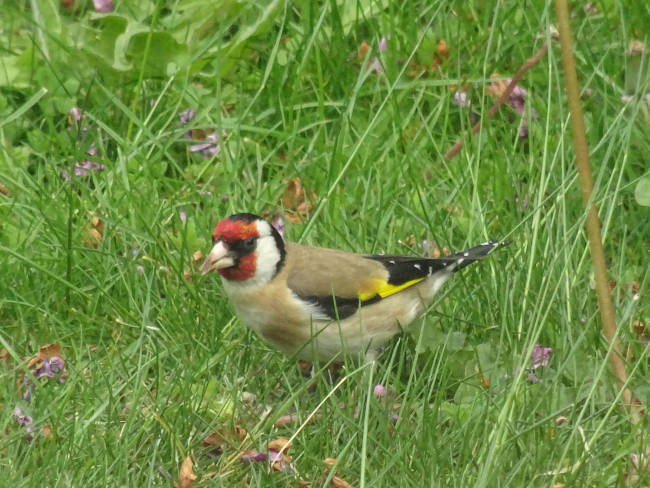
Thursday 21st May
The great tits have fledged and we missed them; they must have gone in the early hours. I am relieved they have successfully fledged, but will miss them a lot. They have provided a lot of entertainment, drama and reinforced that nature’s plight is far more stressful than our modern existence.
Monday 25th May
Another bank holiday!!!! It’s strange having these days off work, but nowhere to go. It’s a shame we can’t bank them and cash them in when the lockdown is lifted.
A cinnabar moth has landed in the garden with its unmistakable red markings. Whilst we might have had many cinnabar moths visit the garden in the 10 years or so we have lived here, the lockdown has given us the opportunity to see what is one of our most beautiful moths.
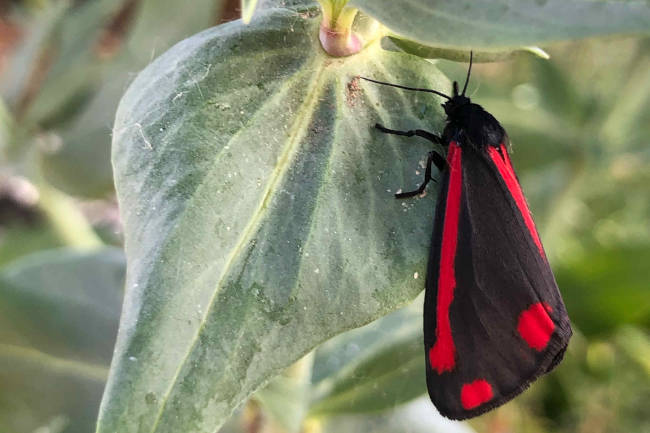
Thursday 28th May
As featured on the daily Self Isolating Bird Club YouTube broadcast (https://twitter.com/SIBirdClub) I downloaded the Seek nature app to my phone (https://www.inaturalist.org/pages/seek_app), which uses the phone’s camera to try to identify wildlife, and it has been great fun walking round the garden trying to identify the plants.
So far it has identified
- brooklime
- ragwort (I wonder if the cinnabar moth will lay eggs on it)
- common ivy
- curled dock
- spotted medick
- germander speedwell
- bristly oxtongue
- herb robert
- wall barley
- creeping cinquefoil
- common yarrow
Quite an impressive list and all growing because we made the decision not to interfere in the garden and to instead try to rewild it.
Even if we are not locked down next year, I think we are going to continue with this mini rewilding experiment.
Sunday 31th May
A new species of bee in the rewilded garden, according to the Seek App it is polymorphic sweat bee, looking it up in one of field guides, it is also known as an orange-legged furrow bee, which is a ground nesting bee. Amongst other ‘weeds’, it was feeding on the ragwort – a plant that certainly would have been dug up if we had maintained a traditional ‘tidy’ garden.
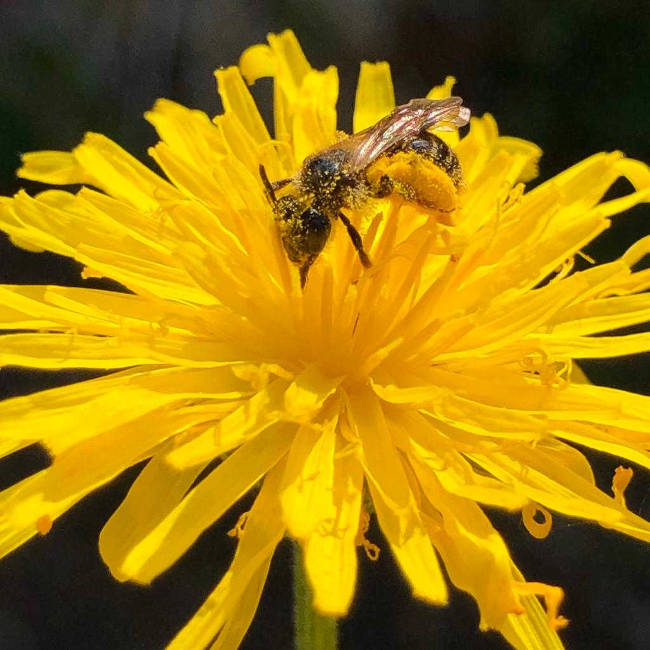
Tuesday 2nd June
Now entering the third month of lockdown, will this ever end (current infections 1,653)? And another hot day (23 C).
Eight red kites flying very low; perhaps someone is feeding them?
And several swifts flying very high.
Saturday 20th June
An evening walk along a small river which flows through meadows near our house – several bats, but the real treat is a barn owl, flying low. These are virtually unseen here; whilst there are plenty of meadows and farmland for them to hunt over, the nearby dual carriage way creates enough noise to prevent them hearing their prey – small mammals – scampering about. But maybe another benefit of the reduced traffic caused by lockdown is an increase in the area where owls can hunt?
Whatever the reason, watching a barn owl hunting has been one of the wildlife highlights of the past four months.
Sunday 21st June
PM – Sat in the garden, reading ‘The Butterfly Isles’ by Patrick Barkham – a fascinating story of the author’s attempts to see every native UK butterfly in one year – and being distracted by baby sparrows, cheeping very loudly as they demand to be fed. And a leaf-cutter bee – a first for the garden – which seems to be making a nest in neighbour’s wall and returning to our garden to find leaves and warm itself on the patio.
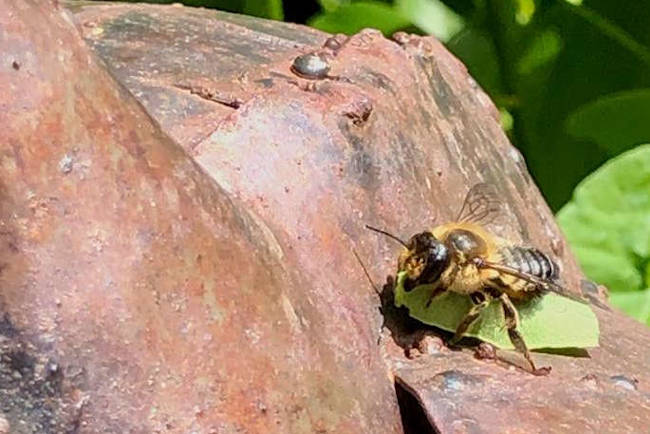
Only one red kite flying overhead. On the 8th May there were over 20; I wonder where they have all gone?
Evening – went out with my DSLR camera to try to get some barn owl photos and typical, it did not show.
Tuesday 22nd June
One month after a cinnabar moth visited our garden, there are two small caterpillars on the ragwort.

Although disliked by livestock owners, it is the main source of food for the cinnabar moth caterpillars, which will now hopefully provide a distraction now the great tits have fledged.
Saturday 4th July
After 114 days the lockdown is now partially lifted (current daily infections are down to 958) – I can go to the pub, buy a book and even get my hair cut.
But for the foreseeable future, I will continue to work from home.
Although it has been a very difficult time, I honestly don’t know how I would have coped if it wasn’t for the nearby wildlife in my garden and the surrounding area.
Update: 25th September
The feared second wave seems to have occurred as 6,874 new cases have been recorded and an autumn and winter of further lockdown measures looms on the horizon, but without the joy of spring it has the possibility of being very difficult.
Even so the nearby wild can still provide a huge source of inspiration, education and enjoyment and some of the things I am looking forward to are:
- Looking for (and trying to identify) fungi in the garden and nearby woods.
- Watching autumn migrants such as fieldfares and redwings arrive in the garden and the locality.
- Getting out the macro lens and try to take photographs of the fantastic fractal shapes produced by frost.
- Hunkering down and losing myself in box sets of wildlife documentaries (there are several on iPlayer, including the iconic David Attenborough series – Life on Earth).
- Reading more wildlife books; I am especially looking forward to Bringing Back the Beaver by Derek Gow.
- Keeping my diary up to date – I would recommend keeping a wildlife diary, as it provides a motivation to get outside, to look for things and to learn more about our nearby wild.
Unfortunately, the hedgehog never returned.
References:
The Flora of Oxfordshire – John Killick et al
Field Guide to Bees of Great Britain & Ireland – Falk & Lewington
British Hedgehog Preservation Society: www.britishhedgehogs.org.uk
British Trust for Ornithology: https://www.bto.org
Field Guide to Moths of Great Britain & Ireland – Waring, Townsend & Lewington
Royal Society for the Protection of Birds: https://www.rspb.org.uk

